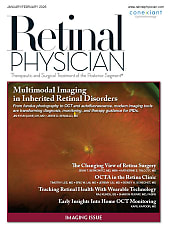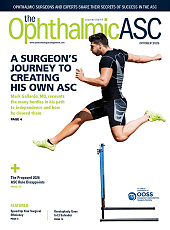For this month's Retina Minute, I have the pleasure of interviewing my dear friend, Veeral Sheth, who is currently clinical assistant professor at the University of Illinois at Chicago.
Dr. Sheth, you presented some incredibly interesting data recently at Clinical Trials at the Summit. Can you share it with our readers?
To preface this discussion, let’s talk about what we are doing in our space today to improve the treatments we have for diabetic macular edema (DME). While we have fantastic treatments now, we can improve durability and efficacy through different mechanisms of action (MOAs). A few years ago, we were introduced to faricimab, a new medication that goes beyond just anti-VEGF to include the ANG-2 pathway in the hopes that we could improve outcomes for our patients.
The data I presented was for a molecule called EB-105. The design rationale was, again, to look at additional MOAs. EB-105 is a novel pentavalent, trispecific fusion antibody. Pentavalent means that the molecule is looking to bind 5 different ligands, specifically VEGF-A, VEGF-B, PIGF, ANG-2, and IL-6R, which is the unique aspect of this medication. The hope is that by addressing the IL-6 inflammation pathway and attacking it, in addition to the other pathways, we can reduce permeability and edema and achieve a better outcome for our patients who are suffering from any pathology that leads to edema or swelling in the retina.
The phase 1 trial was a 3-month, first-in-human, single ascending-dose study that reviewed 3 different doses, starting with 1.6 mg, then moving up to 4 mg, and finally moving up to 8 mg. Patients had DME but could not have proliferative diabetic retinopathy. Coming into the study, they also needed a central subfield thickness (CST) of 325 μm or more and a BCVA between 20/40 and 23/20. These inclusion/exclusion criteria are in line with previous faricimab trials. We looked at safety, tolerability, pharmacodynamics, BCVA, CST, and systemic pharmacokinetics.
Thirteen patients (mean age = 61 years) were included in this trial. They came in with 20/60 vision and CST of 492 μm on average, and they were allowed to have prior treatment with anti-VEGF, though we did have 2 treatment-naive patients in the study. The average number of prior injections was 4.3.
EB-105 was safe and well tolerated. All 13 patients completed the study. One patient in the low dose group got a rescue treatment at month 2, and there were no detectable levels of EB-105 in the plasma. We found no dose-limiting toxicities, serious adverse events, ocular inflammation, or drug-related adverse events (AEs).
What efficacy signals did you find?
We saw a 7-letter gain in patients’ mean BCVA and about a 100 μm improvement in CST. This was just after a single injection and following these patients out to month 3.
We saw good clinically relevant activity at all the observed doses, and we have some great examples of patients who improved 12 letters in the low-dose group (1.6 mg) or 21 letters in some patients who were in the higher-dose groups (4 mg or 8 mg). We also saw significant results on scans and on resolution of CST or fluid buildup after just 1 injection. It is exciting and what you want to see with this type of early phase study.
Was there a dose response curve?
Yes, even with the small number of patients we saw a slight dose response curve. That is important for future studies that will determine doses moving forward.
Was there an extension to this original phase 1 trial?
We do not have data beyond 3 months on these patients, but we know that at 3 months, most patients did well. Again, only 1 patient needed rescue therapy at month 2, and that was in the low-dose group.
Have you been following these patients? Did you see a sustained effect over time?
I think EB-105 has potential for a more prolonged and efficacious effect. The big picture here is there are a lot of factors in the eye that likely impact edema or our ability to treat it. DME is such a multifaceted disease that may require different MOAs. For example, as you know, steroids seem to work better in some patients than anti-VEGF therapies. Because IL-6 is an inflammatory cytokine, we think impacting that pathway may have some viability. We have seen it in postinfectious uveitis or in patients who have noninfectious uveitis with cystoid macular edema patients, so I think this MOA has some legs, and I am excited to see where it goes.
This is fascinating data. What is the next step?
The next step is to roll EB-105 out into a phase 1-2 platform. Obviously, we want to look at longer follow-up for patients, as well as multiple doses.
Is the phase 1-2 already planned?
Yes, it is planned for Q3 of 2025. It will be a multiple ascending-dose study.
I have spent a lot of my career looking at other inflammatory factors besides VEGF in DME, so having a medicine that potentially has a better safety profile than what we currently use is exciting.
I agree. We have had steroids and anti-VEGFs, and then just in the last 2 or 3 years, we have started to look at new MOAs that are actually making it into our hands. To see what they are doing in the real world is fantastic. I am excited that we are continuing to look at new MOAs, combining them with traditional MOAs, and then figuring out how to improve outcomes for our patients.
It was great speaking with you, Dr. Sheth. I am thrilled to hear about the new potential tools in our toolbox.
Thanks, Dr. Singer.










